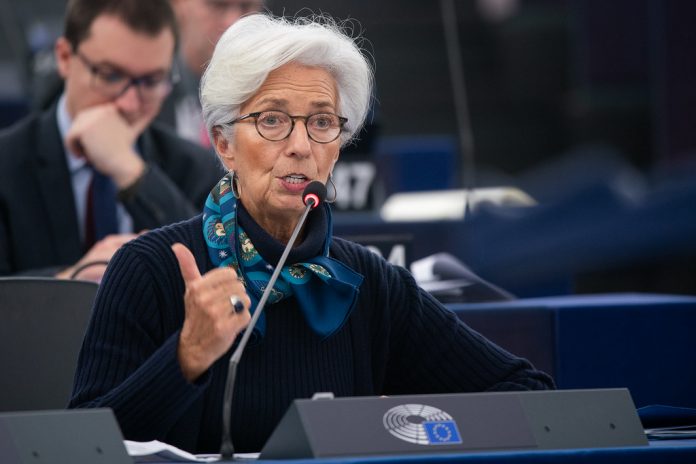
By Eelco Heinen, a Dutch Member of Parliament for the governing “People’s Party for Freedom and Democracy” (VVD)
Prices continue to increase and our purchasing power is under enormous pressure. Still, the causes of inflation are hardly discussed, notes Dutch MP Eelco Heinen. This problem needs to be tackled at the source. The role of the European Central Bank is crucial here. It should end its money printing.
***
Energy prices have been increasing for some time now and global shortages caused by the Covid crisis have pushed prices up further. The European Central Bank (ECB) is however also a major contributor to inflation, and the only one which can prevent it from getting further out of control. Put simply, the more money which is being printed, the more prices will rise.
The ECB’s money printing presses have been running at full capacity for more than a decade now. Since the last economic crisis, the ECB has kept interest rates at a very low level, while also buying up thousands of billions of euros worth of debt and injecting money into the economy.
Euro zone debt conundrum
1. ECB is only buyer of net new periphery debt
2. For yields to stay low, ECB will have to keep buying
3. That's what PEPP reinvestments and TPI are about
4. Low yields mean there's no pressure to reform
5. That enshrines low growth
6. On and on it goes pic.twitter.com/DFuKvDtP8H— Robin Brooks (@RobinBrooksIIF) August 25, 2022
Out of control
Even if this could initially be justified in order to prevent a new crisis, the ECB has gone too far with its policies. In recent years, we have already seen the negative consequences: extremely high housing prices, financial bubbles on stock markets and erosion of pensions.
Meanwhile, inflation has become much more noticeable in our economy. Groceries, petrol, building materials – everything is becoming more expensive. For the first time since 1975, inflation in the Netherlands is now higher than 10 percent. This is an unprecedented and potentially disruptive situation that needs to be addressed quickly.
#Inflation in Germany could hit a 70y high of 10% in autumn amid Russia's natural-gas squeeze, Bundesbank says. https://t.co/XKhMyVUlcf pic.twitter.com/GkWT3WGWNn
— Holger Zschaepitz (@Schuldensuehner) August 22, 2022
Highly indebted countries
Central banks around the world are therefore intervening quickly by turning off the printing presses and raising interest rates. Why is the ECB not doing the same? It fears that highly indebted countries like Italy will immediately get into trouble if interest rates increase too much.
ECB QE had unintended consequences. It created what Germans call "Erwartungshaltung," an expectation that spreads are always low. Take Banca d'Italia Governor Visco, who on June 16 – just before Draghi's gov't fell – said Italy's spread should be < 150 bps based on fundamentals. pic.twitter.com/hWlZG78iZQ
— Robin Brooks (@RobinBrooksIIF) August 21, 2022
Because the ECB has been buying up all kinds of debt in Europe for years, these highly indebted countries have simply been able to postpone necessary reforms, something which enables debt to increase even more. Without the ECB’s purchasing programmes, the debt of these countries would soon become unsustainable.
So what is the ECB’s solution? More debt purchasing! This time targeted at the debt of the problem countries themselves, Italy in particular. This is a panic reaction whereby the ECB is going way beyond its mandate. It violates the ban on ECB monetary financing of governments, which is laid down in the EU Treaty.
ECB spread targeting at work: volatility of Italy's spread is near all-time lows in the run-up to the pivotal election on Sep. 25. Europe needs to ask itself 2 questions: (i) what does this have to do with monetary policy; and (ii) don't stable spreads embolden Italy's populists? pic.twitter.com/F3y7jbvYK3
— Robin Brooks (@RobinBrooksIIF) August 27, 2022
The ECB has now concocted yet another 'Protection' and 'Enhancement' panacean non-laws-non-violating mechanism with a brilliantly catchy name of 'Transmission Protection Instrument' that allows it to pretend that the ECB is not keeping Italy on life support so it can keep +
— Constantin Gurdgiev (@GTCost) July 22, 2022
De #ECB neemt een ongekende afslag met de introductie van #TPI. Hiermee wordt de ECB meer politiek en minder onafhankelijk. Dit verzwakt de euro.
Juridische basis van TPI blijft ook zeer twijfelachtig door gebrek aan extra voorwaarden van hervormingen (1/3)
— Eelco Heinen (@eelcoheinen) July 22, 2022
Moreover, this does not solve the structural problems, because as a result, the problem countries will not reform, which means that debts will increase further and that the ECB will eventually need to intervene again. In this way, the ECB continues to chase its own tail.
The ECB should stop these monetary schemes and it should quickly start fighting inflation. It is then up to national governments to tackle the economic problems in those euro countries. For instance, by tightening budgetary rules.
Dutch parliament adopts motion questioning the legitimacy of the recently proposed #ECB anti-fragmentation tool.
Parliament calls upon government to speak out against any tool conflicting with the prohibition on monetary financing and to uphold budgetary discipline in Europe. pic.twitter.com/UfhqBngv4H
— Eelco Heinen (@eelcoheinen) July 8, 2022
No amount of ECB spread control and no rejiggering of Europe's fiscal rules will fix Italy. These things can only buy time. The only thing that will fix Italy is deep labor market reform. Look at how bad prime-age participation in Italy is for men (lhs, red) and women (rhs, red). pic.twitter.com/9ZdEK9g3AW
— Robin Brooks (@RobinBrooksIIF) August 29, 2022
The wrong solution
Some countries, France in particular, are now arguing for a relaxation of those budget rules. This is really the wrong solution. It is like countering floods by further opening the sluices.
The Netherlands will need to make clear that a relaxation of fiscal rules for problem countries will not be possible without structural reforms. Not more, but less debt is needed.
If we want to tackle inflation at its source, the importance of budgetary discipline throughout Europe must be reaffirmed. Starting with stopping the ECB’s money printing presses.
De inflatie in ongekend hoog, maar over de oorzaken van de #inflatie gaat het nauwelijks. „Dit probleem moet bij de bron worden aangepakt. De rol van de Europese Centrale Bank is hier cruciaal.” Stop de geldpersen van de #ECB.
Lees in @telegraaf mijn opinie👇🏼 pic.twitter.com/mvmESUkIz0
— Eelco Heinen (@eelcoheinen) August 24, 2022
Originally published in Dutch by De Telegraaf
Disclaimer: www.BrusselsReport.eu will under no circumstance be held legally responsible or liable for the content of any article appearing on the website, as only the author of an article is legally responsible for that, also in accordance with the terms of use.












